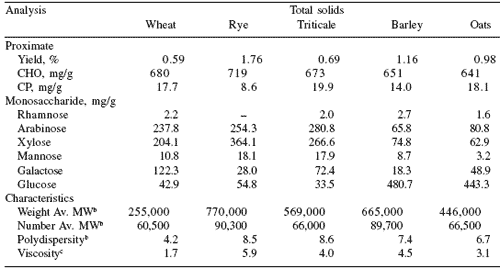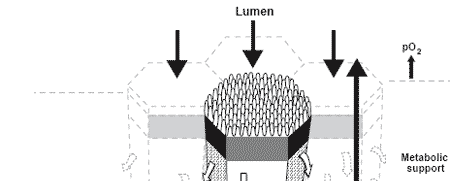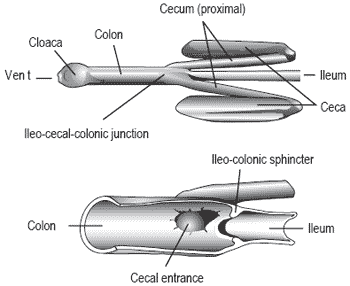Nutrient recovery by the small and large intestine of fowl
The small intestine employs the bird’s own enzymes to effect digestion then rapidly captures resulting nutrients at its expansive surface. Small intestinal recovery is heavily dependent on convection driven by motility to minimize microbial use.
Conversely, the large intestine subsequently employs an extensive symbiotic microbial population to finalize nutrient recovery before voiding waste. Motility in the large intestine is largely involved in segregating fiber sensitive to microbial action while voiding the coarse material.
Fiber associated with plant feedstuffs can exert considerable influence on small and large intestinal function by virtue of its solubility in water and physical characteristics. Fiber’s structure and relationship with water in the lumen greatly influence convective efficiency and microbial dynamics throughout the intestine.
Small intestine
MOTILITY
Mixing of lumen contents concurrent with maximizing concentration difference at the intestinal surface is dependent on motility. Initiation of digestion by pancreatic enzymes largely occurs in the duodenum while the jejunum and ileum are more concerned with nutrient recovery upon release.
Differences among these parts are a function of rate of digestion and absorptive capacity. Motility is essential to convection with exchanges occurring at two distinct areas. Fowl extensively employ the circular muscle layer for refluxive peristalsis to maximize villi exposure while fibers originating from muscularis mucosa rotate each villus to further facilitate differences at its surface.
Pancreatic enzymes generally reduce nutrients from large complexes to small secondary forms that are particularly soluble.
The enterocyte finalizes digestion at its luminal surface to simple units for absorption, then transfers nutrients through the basolateral membrane to the circulatory system.
Each enterocyte has a surface expanded by microvilli with an attached glycocalyx.
Goblet cells provide mucin that engulfs villus microvilli and their glycocalyx to produce the ‘unstirred water layer’.
Essentially mucin has repeating polypeptide units held together by cystine, then repeating units have large amounts of threonine and serine with connecting carbohydrates to create a ‘bottle-brush’ structure. Mucin’s hydrodynamic associations with water together with interlinking create a micro-net that limits sugars, peptides and fat micelles to the enterocyte surface.
Once ‘macro motility’ by peristalsis and villi rotation has enabled products of pancreatic enzyme digestion to enter the enterocyte’s unstirred water layer, then ‘micro motility’ of underlying microvilli facilitates contact to finalize digestion and absorption.
SURFACE ADAPTATION
Villi are rapidly and continuously responding to lumen conditions. Maintenance of the surface and cost of accommodation is expensive. Villi can either increase or decrease their length to alter surface area to optimize cost of maintenance for recovery relative to productive advantage. All changes originate with proliferation of stem cells in the crypt.
Enterocytes and goblet cells evolve in proportion to need then mature to support surface obligations as they ascend.
The intestinal surface arising with embryological development is focused on macromolecular transfer while in ovo. Transition of this surface to one competent at digestion-absorption coincides with depletion of yolk sac reserves and self sufficiency.
Extensive increases in villi prominence and surface digestive enzymes occur through the first seven days after hatch. Access to food at this time has a dramatic effect on the rate of transition, surface cell proportions, and nature of mucin in the unstirred water layer.
FIBER
The structure of fiber is such that a wide array of physical conditions may be created within the small intestinal lumen. Primary cell walls approximate 90% cellulose, hemicellulose and pectic acids with 10% of three types of structural proteins.
Cellulose is a very large composite of glucose polymers that provide the bulk of structural strength. Xylans are small carbohydrate polymers that hydrogen bond to cellulose fibers with pectic acids acting as an intermediary connection to other xylans and fibers.
Glucans appear to be an additional hemicellulose largely associated with grain endosperm. As the necessity for wall strength increases, so also does the proportion of cellulose at the expense of the other polymers.
Seed endosperm cells are not in need of strength as much as cohesiveness; thus, hemicelluloses dominate with many being soluble. As the amount and structural complexity of these soluble ‘non-starch polysaccharides’ differs among the grains (Table 1), so does the viscosity of their solutions.
Insoluble fiber is generally innocuous during its journey through the small intestine.
If feed formulation leads to an increase in fiber that decreases the plane of nutrition, then enhanced motility increases luminal throughput while the villus lengthens.
Increase in the level of soluble fiber has similar effects but repercussions may be further encountered if viscosity of lumen contents also increases. Increasing viscosity of lumen contents not only decreases laminar flow and convective efficiency with villi for nutrient absorption, but gas exchange between wall and digesta also lessens.
A lower partial pressure for oxygen together with increased concentrations of nutrients can enhance development of transient microbes, particularly anaerobes. The chick is known to suffer from digesta viscosity problems when coliforms, streptococci, and clostridia dominate the flora early in life until the more favorable lactobacilli become competitive.
Increasing exposure of coliforms concurrent with the displacement of embryo enterocytes from the villus early in life greatly threatens the chick by their translocation through imperfections of the surface. Conveying an extensive and disproportionate microflora from the environment compounds impaired nutrient recovery and live performance when viscous non-starch polysaccharides are present (Figure 1).
Conventionally reared chicks have been shown to greatly magnify the adverse effects of viscous pectins compared to germ-free conditions while aberrations in villus shape and expanded anaerobe numbers are apparent.
Table 1. Properties of water-soluble non-starch polysaccharides from several grains high in concentrationsa.
aSelected data from Girhammar and Nir (1992) on one variety of each grain.
bMolecular weight based on weight and number of polymers while polydispersity is their ratio.
cViscosity in millipascal seconds relative to water at 0.

Figure 1. Flow of nutrients through the mucosa.
Supplementation of feed with enzymes that cleave internal bonds to reduce molecular complexity can greatly reduce viscosity of hemicellulose solutions. Given that xylan structure and its molecular complexity differ markedly among the grains, so also does enzyme specificity for endohydrolysis and viscosity relief.
Repercussion of digesta viscosity largely involves increased cost of maintaining an expanded mucosa in response to an expanded microbial population that competes for nutrients. Viscosity per se also does not greatly impair nutrient uptake with exception of fat. Reduced frequency of wall contact by the large lipid digestion micelles appears to be at fault.
Broad-spectrum antibiotics can relieve the adverse effects of soluble fiber to the extent of microbial sensitivity. Similarly, xylanase-glucanase supplements are just as effective as their compatibility with fiber source. Thus, combinations of enzyme and antimicrobial supplements are usually better than either one alone but do not provide an additive improvement.
Viscous solutions of non-starch polysaccharides impair chick performance to the greatest extent early in life when their microbial population is evolving and mucosal surface area represents the limiting facet of growth rate. Broad-spectrum antibiotics measurably decrease maintenance need of small intestinal mass to the advantage of production.
Large intestine
MOTILITY
Coordinating movement of contents in ceca, colon and cloaca is central to effective operation. The ileocolonic valve intermittently opens to enable entry of indigesta into the colon. Gentle refluxive peristalsis ‘washes’ indigesta with urine from the cloaca while ‘pushing’ resulting fluids and fines into the ceca (Figure 2).
This size limitation of particulates is due to the ceca’s small entrance together with projection of villi into the lumen. Villi profile rapidly diminishes such that ‘blunting’ ultimately prevails in the ceca’s body to give the appearance of a flat mucosa, and volume in the body is far greater than both colon and coprodeum. These blunt villi have goblet cells largely located in the crevices while enterocytes predominately face the lumen.
Figure 2. Large intestinal complex of the fowl.
Cecal enterocytes can actively transport nutrients immediately after hatch but subsequent turnover of the surface leads to cells being passive in this respect. Early active transport appears to compensate for a concurrent limited capacity by embryonic enterocytes in the small intestine.
Although the cecal wall can passively absorb nutrients in general, resident microbes present an infinitely greater surface area for recovery in the lumen. Thus, nutrient absorption by the cecal wall largely represents an excess of microbial need and/or ‘waste’ from their metabolism.
Effective cecal functioning depends on a population of microbes that are continuously provided in digesta and held in an anerobic environment. Strict anaerobes dominate the population, and oxygen limitation depends on a thick mucus layer with gentle motility to minimize diffusion from the wall.
CECA RESTRICTIONS
Using soluble fiber and fine particulates enhances the efficiency of microbial fermentation. Entry of urine enables substantial recovery of associated water and minerals, particularly sodium, while carrying fiber especially suited for rapid fermentation to volatile fatty acids (VFAs) and waste nitrogen when dietary crude protein is lacking.
Coarse plant particulates have generally maintained their integrity because of high proportions of cellulose, whereas high proportions of hemicellulose and pectin permit disintegration. In turn, feedstuffs that generate fine particulates with grinding and feed manufacturing practices generally favor entry into the ceca and energy recovery as VFAs.
The caloric value of non-starch polysaccharides (and undigested starch) recovered as VFAs approximates 1 kcal/g or 25-35% of the original monosaccharide. Although a large part of feed’s ‘neutral detergent fiber’ may be fermented to VFAs, its contribution to metabolizable energy (ME) varies considerably with plant source and sugars involved.
Ceca are inoculated after emergence from the shell with microflora from the environment, then representative membership progressively matures as access to fiber and anerobic conditions develop.
Duration to competence at fermentation and meaningful formation of VFAs to ME is variable. Inclusion of readily fermentable substrates, such as lactose, greatly enhances early VFA production with chicks. Broad-spectrum antibiotics appear to delay population maturity, but meaningful amounts of VFAs can eventually be attained to suppress Enterobacteriacae number.
Although antibiotics can be of advantage to performance of the young bird when extensive microbial levels occur in the small intestine, any advantage in terms of the ceca seem minimal given their variable influences on the population and rate of fermentation.
Summary
Nutrient absorption occurs from the intestinal surfaces. Strategy in nutrient recovery by the small intestine is opposite to that of the large intestine. Duodenum, jejunum and ileum have a very expansive mucosa by virtue of villi and microvilli, whereas the ceca have a low profile surface.
Refluxive motility and villi movement within the small intestine provides convection between lumen contents and villi surfaces while contractile elements move microvilli to enhance transfer to enterocytes. Refluxive motility in the colon separates fine from coarse particulates of indigesta and cecal entry is restricted to fluid and fines.
Microbes in the small intestine reflect the bird’s environment while aerobes dominate due to oxygen from the wall. Microbes in the large intestine are highly concentrated with oxygen minimized to support anaerobes.
Plant fiber that has high proportions of cellulose lends itself to coarse feed particulates, whereas fibers high in hemicellulose-pectin combinations are fine and may be partially soluble. Fiber generally acts as a dietary diluent with coarse particulates being more rapidly evacuated than either soluble non-starch polysaccharides or fines.
Soluble non-starch polysaccharides that create viscous conditions within the small intestinal lumen adversely affect live performance because of impaired efficiency of convection, reduced rate exchanges with the mucosa, and an expanded microbial population. Both non-starch soluble fiber and the fine particulates are readily fermented to VFAs in the ceca that contribute to metabolizable energy.
Reference
Girhammar, U. and B.M. Nair. 1992. Certain physical properties of water soluble nonstarch polysaccharides from wheat, rye, triticale, barley and oats. Food Hydrocolloids 6:329-343.
Author: EDWIN T. MORAN, JR.
Poultry Science Department, Auburn University, Auburn, Alabama, USA








.jpg&w=3840&q=75)